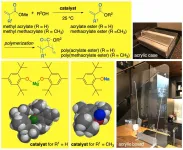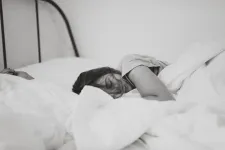Where and when is economic decision-making represented in the brain?
Researchers at the University of Tsukuba report that monkeys calculate expected value when making economic decisions, and that these calculations are signaled in two regions of the brain
2021-02-10
(Press-News.org) Tsukuba, Japan -- Economists have been using game theory to study decision-making since the 1950s. More recently, the interdisciplinary field of neuroeconomics has gained popularity as scientists try to understand how economic decisions are made in the brain. Researchers led by Professor Masayuki Matsumoto and Assistant Professor Hiroshi Yamada at the University of Tsukuba in Japan studied populations of neurons across the monkey brain reward network to find out where and when expected value is calculated.
The team trained monkeys to perform a lottery task for a reward. The monkeys saw two pie charts on a computer screen. The colors in the charts told the monkeys the size of the reward and the probability of getting it. Mathematically, the expected value is the size of the reward multiplied by the chance of getting it. Thus, a highly probable large reward would create a high expected value and a small reward with a low probability would create a low expected value. The monkeys consistently chose the pie chart that depicted the higher expected value, and behavioral models showed that their decisions were indeed based on this integrated value, not simply the probability or the size of the reward.
The brain has a network of connected regions that all have functions related to processing rewards. The researchers recorded brain activity from four regions that have been implicated in decision-making: the cOFC, mOFC, VS, and DS. They analyzed brain activity when monkeys simply saw one pie chart, but did not have to make any choice. This allowed the researchers to identify brain regions involved in calculating the expected value, not those involved in making choices. They found that all four regions contained neurons that responded to parts of the calculation. Nevertheless, state-space analysis showed that as a population, only the cOFC and VS stably represented the calculated expected value. Additionally, these two regions also stably represented risk-return.
Although both the cOFC and VS integrated reward size and probability, the team noticed that brain cells in these regions did not behave the same way over time. Analysis showed that the expected value signals in the cOFC developed quickly, while those in the VS developed gradually each time the monkey saw one of the pie charts.
Finding that only the cOFC and VS signal expected value differed from previous studies. "Our use of state-space analysis as a means to characterize the dynamics of neuronal populations was the key," explains Matsumoto. "Using this method, we were able to see differences in both stability and as well as the time course of the signal."
INFORMATION:
The article, "Neural population dynamics underlying expected value computation," was published in The Journal of Neuroscience at DOI: https://doi.org/10.1523/JNEUROSCI.1987-20.2020.
ELSE PRESS RELEASES FROM THIS DATE:
2021-02-10
Black carbon (BC) is the product of incomplete combustion of fossil fuels, biofuel, and biomass. By strongly absorbing solar radiation, BC can heat the atmosphere, affect its stability, and further deteriorate air quality.
The climatic and environmental effects of BC are determined by its loading in the atmosphere. Scientists find that microphysical characteristics of BC, such as particle size and mixing state, can also influence these effects.
The team pointed out that the reduction of the thickly coated BC would further lead to a decline of solar radiation absorption by atmospheric aerosols, besides the decline resulting from the BC loading ...
2021-02-10
Clostridioides difficile infection (rCDI) occurs in the gut and is caused by the Gram-positive, spore-forming anaerobic bacterium, C. difficile when its spores attach to fecal matter and are transferred from hand to mouth by health care workers. Patients undergoing antibiotic treatment are especially susceptible as the microorganisms that maintain a healthy gut are greatly damaged by the antibiotics.
Treatment of rCDI involves withdrawing the causative antibiotics and initiating antibiotic therapy, although this can be very challenging. Fecal microbiota transplantation (FMT) is considered an effective alternative therapy as it addresses the issue from the ground up by replacing the damaged microflora with a healthy one through a stool transplant.
However, two deaths caused by antibiotic-resistant ...
2021-02-10
Plant nanosensors and Raman spectroscopy are two emerging analytical technologies and tools to study plants and monitor plant health, enabling research opportunities in plant science that have so far been difficult to achieve with conventional technologies such as genetic engineering techniques
The species-independent analytical tools are rapid and non-destructive, overcoming current limitations and providing a wealth of real-time information, such as early plant stress detection and hormonal signalling, that are important to plant growth and yield ...
2021-02-10
The percept of time relates to the sense of touch. A new SISSA study "A sensory integration account for time perception" published in PLOS Computational Biology uncovers this connection. "The challenge to neuroscience posed by the sense of time lies, first and foremost, in the fact there do not exist dedicated receptors - the passage of time is a sensory experience constructed without sensors," notes Mathew Diamond, director of the Tactile Perception and Learning Lab. "One might imagine a precise clock in the brain, a sort of stopwatch that registers the start and stop and computes the elapsed ...
2021-02-10
A University of Arizona Health Sciences study has estimated total lifetime costs at $736 million for the 10,359 valley fever patients diagnosed in Arizona in 2019, underscoring the economic burden the disease places on the state and its residents.
The prevalence of valley fever, formally known as coccidioidomycosis or cocci, has increased in recent years, from 5,624 cases diagnosed in Arizona in 2014 to 10,359 cases in 2019. There currently are no certain means of prevention or vaccination for the fungal disease, which is caused by spores of Coccidioides, a family of fungi found in soils of the Southwest.
The findings highlight the need ...
2021-02-10
Feb. 10, 2021 - A new paper published online in the Annals of the American Thoracic Society describes a "virtual" recovery program for sepsis patients that may also help post-COVID-19 patients and survivors of other serious illnesses.
In " END ...
2021-02-10
Scientists from Nanjing University and the University of Macau have devised a new approach to extend the survival of transplanted probiotics in vivo, enhancing the efficacy of cancer chemo-/immunotherapies in mice. The paper entitled "Smectite promotes probiotic biofilm formation in the gut for cancer immunotherapy" appears online today in Cell Reports.
The gut contains trillions of symbiotic bacteria. Disturbing the balance of intestinal flora may increase the occurrence of major diseases, including cancers. The gut microbiome plays an essential role in regulating the host immunity, which has inspired strategies to modulate intestinal microorganisms ...
2021-02-10
Nagoya University scientists have developed a chemical reaction that produces high yields of a compound used in a wide variety of industries, without needing high temperatures or toxic catalysts. The approach was described in the journal ACS Catalysis and offers a practical and sustainable solution for industrial (meth)acrylate (= acrylate or methacrylate) ester synthesis.
(Meth)acrylate esters are used in industrial coatings and masonry, and to make plastics, dyes and adhesives. But the chemical process for making them from methyl (meth)acrylates ...
2021-02-10
As families settle back into a new school year, sleep experts at the University of South Australia are reminding parents about the importance of teenagers getting enough sleep, cautioning them that insufficient sleep can negatively affect their mental health.
In a new research paper, UniSA sleep experts Dr Alex Agostini and Dr Stephanie Centofanti confirm that sleep is intrinsically linked to mental health, but is commonly overlooked by health practitioners as a contributing factor.
Dr Agostini says it's imperative that parents and medical practitioners ...
2021-02-10
For all their importance as a breakthrough treatment, the cancer immunotherapies known as checkpoint inhibitors still only benefit a small minority of patients, perhaps 15 percent across different types of cancer. Moreover, doctors cannot accurately predict which of their patients will respond.
A new study finds that inherited genetic variation plays a role in who is likely to benefit from checkpoint inhibitors, which release the immune system's brakes so it can attack cancer. The study also points to potential new targets that could help even more patients unleash their immune system's natural power to fight ...
LAST 30 PRESS RELEASES:
[Press-News.org] Where and when is economic decision-making represented in the brain?
Researchers at the University of Tsukuba report that monkeys calculate expected value when making economic decisions, and that these calculations are signaled in two regions of the brain







